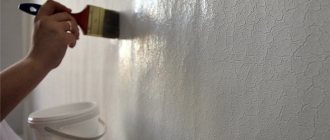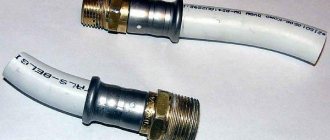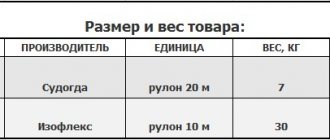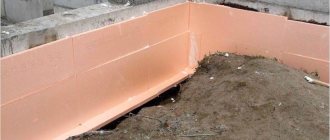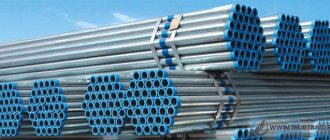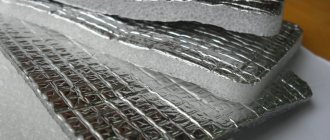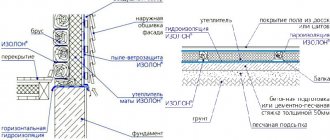Professional mounting foam TECHNONICOL 240 fire-resistant 1000 ml. Photo Petrovich
Fire safety is one of the indicators of the quality of constructed buildings . To achieve the required parameters, special materials are used , the list of which includes fire-resistant (fire-resistant, fire-resistant) polyurethane foam.
Polyurethane compounds are excellent insulators and protect against smoke, toxic gases and fire. Polyurethane foam is used in cases where a high level of fire protection is required. After all, if the main building materials are stable, then the auxiliary ones must meet similar requirements.
What is fireproof foam, features, advantages and disadvantages
Fire-resistant foam is one of the types of mounting compounds . It is a one- or two-component composition that increases its own volume after application. As the mixture hardens, it acquires a rigid shape, which makes it possible to fix various structures: window frames, door blocks and others. The basis of fire-resistant foams is liquid polyurethane . The composition also includes other components , each of which performs its own functions:
- catalysts make it possible to use foam at sub-zero ambient temperatures;
- stabilizers ensure uniform application and consistency of consistency on various surfaces;
- the gas ensures that the composition is pushed out of the cylinder;
- foaming agents (foaming agents) provide an increase in the volume of the mixture and its hardening;
- the fire-resistant properties of the foam are determined by antiprenes (usually mineral ones) and graphite or similar substances;
- dyes impart a red or pink color, which makes it possible to distinguish fireproof foam from regular foam and determine the fire resistance of the composition.
Reference. Fire-resistant foam may be inferior to conventional compositions in terms of foam formation.
The principle of “work” for refractory materials is standard: when sprayed, it approximately doubles in size, hardens and creates a high degree of adhesion, polymerization occurs due to internal chemical reactions or exposure to moisture present in the air.
Fire-fighting compounds have standard properties:
- high adhesion with various building materials, does not adhere well to plastics, glass, polyethylene;
- ease of use and processing, excess is easily cut off;
- resistant to mold, mildew and high humidity;
- retains its properties at temperatures ranging from -60 to +100 degrees Celsius;
- bio- and chemical resistance.
Polyurethane foam Tytan B1 fireproof professional 750 ml. Photo Petrovich
A feature of fire-resistant foams is the ability to withstand temperatures up to 1000 degrees . It does not ignite when exposed to open flame for a certain period of time indicated on the packaging and labeling. After this time, the foam still lights up, but when the flame stops it goes out on its own. Exposure to high temperatures does not cause the mixture to melt, flow or drip.
The disadvantage of fire-resistant polyurethane foam is the lack of resistance to ultraviolet radiation . Direct sunlight causes destruction. Therefore, after application, processing is necessary: painting, applying plaster or putty.
Gun for polyurethane foam: price, rules of use and device
The use of a gun is provided by most manufacturers of polyurethane foam. It is important to note that this tool greatly simplifies the work and helps to use the substance as rationally as possible, as it allows you to adjust the dosage of the material.
The gun makes it easy to stop foam flow by simply releasing the trigger lever. At the same time, the foam does not harden in the device itself, because the needle reliably blocks the air supply, as a result of which there is no need to clean the gun. If necessary, it can be quickly changed.
Thanks to the gun, you can apply foam with one hand, and in the most awkward positions. High-quality models usually have wear-resistant parts. Correct and competent operation guarantees a long service life.
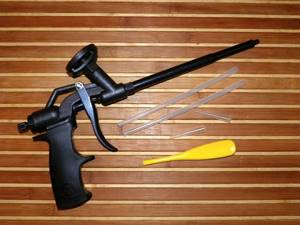
Guns for polyurethane foam Intertool are low cost and of good quality
The most common pistols are imported - Intertool, Sigma, Tope, as well as domestic ones - Brigadier, Zubr. These models are distinguished by their low price (from 600 rubles) with fairly acceptable product quality.
Guns for polyurethane foam Hilti, Neo, Yato are a higher class of device. Popular with professional builders. One such tool can be used in the process of using more than a hundred cylinders. The price starts from one and a half thousand rubles for one pistol.
Which spray foam gun is better: selection criteria and rules of use
When choosing a pistol, the main criterion is the material used to make the different parts. It is desirable that the parts have a Teflon or fluoroplastic coating on the parts, due to which the foam will not stick to them. This will make cleaning the product several times easier.
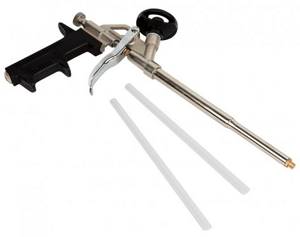
A quality pistol should be comfortable and moderately heavy
Helpful advice! You can determine the presence of fluoroplastic by running your fingers over the surface. When touched, a feeling of a greasy film should appear. It is important not to confuse this coating with a conservation lubricant.
The components of the gun must be made of metal, ensuring its strength and durability. It is necessary that the handle has a comfortable shape, does not “dig into” the palm, but lies “like cast”. The trigger at the end should have a slight bend, which will prevent the finger from slipping off. Its length indicates how many fingers will be used when pressing.
When purchasing, you should beware of a gun that is too light or heavy, and you should also pay attention to the cylinder holder and the valve with the locking ball placed in the center. You should not buy a gun with a plastic valve ball.
It is important to have a foam dispenser that regulates its supply. In the end, the gun must be clean, free of process dirt and debris. A quality pistol's trigger is tested at the factory. The presence of pressure can be checked by pressing.
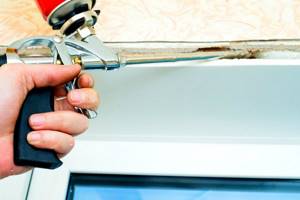
As a rule, in high-quality pistols, parts are coated with Teflon or fluoroplastic
It is necessary to test the tool for leaks using a foam gun that contains acetone. It is advisable to always have flushing fluid on hand. To check, a bottle of liquid is installed on the gun, then with a few presses of the trigger, the gun tube is cleared of preservative grease and filled with liquid. Then the balloon is removed and left for a couple of days. Once the trigger is pulled on a sealed gun, pressurized fluid will burst out of the gun.
Types of fireproof foam, markings
Classification of fire-resistant compositions is carried out according to several criteria:
Scope of application. Household and professional. A significant part of the fireproof foam on the market is of the second type. Compositions for professional needs are produced in large-volume cylinders, the capacity of which exceeds 750 ml. They are designed to mount a pistol. Household formulations are equipped with a special plastic applicator tube. Professional foam has better resistance to open fire.
Professional fireproof mounting foam KRAFTOOL Kraftflex Premium B1 750 ml. Stroylandia Photos
Fire resistance class. The time during which the foam successfully resists the effects of an open flame depends on the fire resistance class, indicated by the marking on the cylinder:
- B1, highest fire resistance. Designed for insulation of buildings with increased fire safety requirements and with a maximum concentration of people. Used when installing stoves, fireplaces and other equipment that creates an increased danger. Retains properties during prolonged exposure to an open flame and does not support combustion.
- B2, middle class (level) fire resistance. Used for low-traffic structures. Cannot withstand open fire for a long time. When exposed to high temperatures, it melts and releases a small amount of toxins. Extinguishes on its own when the flame is removed. Suitable for sealing water supply, sewer and thermal communications.
- B3 - flammable foam , which is not popular in modern construction due to low efficiency, self-extinguishes when the flame stops.
Fire resistance coefficient is a parameter demonstrating the time of resistance to open fire at a temperature of 1000 degrees, measured in minutes, indicated in the marking, for example, EI 30 . The foam does not catch fire and retains its properties for 30 minutes. Compositions of this type are recommended for use in buildings with occupancy of no more than 300 people. EI 60 and EI 90 resist fire for 60 and 90 minutes, respectively, and are intended for use in educational and medical institutions, shopping centers. EI 120, EI 240 and EI 360 are compounds that provide the highest level of protection, resisting fire for up to 360 minutes. Suitable for buildings that have increased fire safety requirements.
Season of application, temperature conditions during application. There are summer, all-season and winter foam. Summer must be applied at temperatures from +5 to +30/35 degrees. All-season is recommended for use in summer or spring/autumn, so temperatures range from -5 to +30, in some cases - from -10 degrees. Winter foam is suitable for application at a temperature of at least -18; there are options that can withstand temperatures of -25 degrees, but they are not fire-resistant. In most cases, fire-retardant compounds are of the all-season type.
Expansion coefficient , which significantly affects material consumption, is measured as a percentage. Strongly expanding ones can increase in volume five times. Moderately expanding - three, weakly - two. Compositions with a low expansion coefficient are also common on the market; the minimum is 15%.
Reference. Using foam at sub-zero temperatures reduces the expansion coefficient. As a result, the volume of the mixture will be less than when used at higher temperatures.
Compound. One-component foam hardens at normal air humidity. Before application, it is recommended to moisten the surface to increase adhesive properties. To obtain the best result, the surface must be cleaned and primed. The two-component hardens during a chemical reaction.
Foam yield - the amount of composition obtained from one cylinder, measured in liters, often indicated in the labeling. The most popular options are those with a capacity of up to 65 liters.
How long does it take to dry? The time of film formation on the surface, processing and complete polymerization are shown on the cylinder.
Color. The main colors are red, pink, brown.
Brand overview
The modern market offers a wide range of polyurethane foam. To be sure to choose a high-quality material, you should purchase a can from a well-known and trusted manufacturer.
Ognez
Fire-resistant polyurethane foam Ognez is produced in Russia. Some characteristics:
- Fire resistance limit – EI 240;
- Application temperature +5…+35°С;
- Operating temperature -40…-80°С.
Ognez foam can be applied in slight cold of at least +5°C, but it is necessary to heat the container itself to +18°C. The sealed material can withstand 2 freeze-thaw cycles for up to 90 days without losing its original characteristics.
Ogneza is economical: 45 liters of foam come out of a 935 g can! Affordable price is another advantage of the product from the presented brand.
Macroflex
Makroflex presents a large series of mounting foams, among which there is fire-resistant Makroflex FR77. It has a wide range of applications:
- Sealing seams during the construction of panel houses;
- Fixing windows and doors in openings;
- Laying and fixing heating pipes, sewer pipes, etc.
The material from German developers is tested in accordance with European and international standards. The brand is known for producing reliable building components that have stood the test of time.
Macroflex fire-resistant polyurethane foam is universal: its safety class is sufficient for use in public places, in residential apartment buildings and private buildings, and in industrial premises.
SOUDAFOAM FR (Soudal)
Fire-resistant mounting foam soudafoam fr is distinguished by an increased range of permissible operating temperatures and a fire resistance coefficient of EI 360. This material will ensure maximum safety for the room and people in the event of a fire - the hardened foam does not support combustion and self-extinguishes after the fire source is removed.
The applied foam polymerizes at normal humidity 60% for 2 hours at a layer of 30 mm.
Advantages of this insulator:
- High degree of protection;
- Effective consumption (from 33 to 45 liters of foam is obtained from a liter cylinder);
- High filling capacity;
- Increased adhesion to different surfaces;
- Stable layer without shrinkage and cracking;
- Available in different cylinders (with a tube or for a pistol).
Fire-resistant polyurethane foam DKC
A budget but practical foam insulator of the Italian brand, originally from China. The material is used for instant insulation and fixation of window and door openings, electrical equipment.
Fire resistance temperature +150°C. Such foam can only be used in walk-through areas with a small flow of people or in utility rooms of private houses. Operating temperature range -5…+40°С. Suitable for indoor use only.
- Engineering Communication
- Exterior finishing
Areas of application of fire-fighting foam
Fire-resistant polyurethane foam is intended for use in places that are subject to fire safety requirements catering establishments, restaurants and cafes; shopping centers.
Construction and repair work, sealing and fixing with fire protection are carried out using polyurethane foam, namely sealing openings when laying engineering systems and cables, insulating electrical wires, switches, connectors and sockets, water supply and heating systems, installing partitions, ceilings and fire doors.

Gun foam Mastertex B1 fireproof 750 ml. Photo by Leroy Merlin
SNiP also contains recommendations for the use of : sealing seams and joints near stoves and fireplaces, chimneys; for baths and saunas, in particular for insulating equipment; for gaps between frames with high fire safety standards.
In addition, fire-resistant foam is used:
- in work that requires insulation and fire protection, insulation of roofs, attics, attics;
- for thermal and noise insulation, sealing of engine compartments and car interiors;
- It is also recommended for conventional installation; it is better to choose foam with a low fire resistance coefficient than the standard option.
Heat-resistant chimney foam
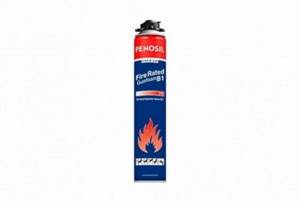
It is much more convenient to repair brick stoves and fireplaces using modern construction chemicals. Moreover, various sealing compounds are used during the construction or installation of chimneys.
The essence of the problem: from a wide range of products, the homeowner needs to choose a heat-resistant sealant that can withstand extreme operating conditions inside the stove masonry, chimney pipe, and so on.
Our publication will help you make the right choice.
Let's outline the scope of application
Construction supermarkets sell many sealing pastes used in heating, plumbing and sewerage systems. It must be understood that ordinary food and sanitary compounds do not belong to the high-temperature category, although they are used for the installation of some elements of chimney pipes.
Deep cracks can be covered with mortar, but it is better to fill them with sealing material
Water- and heat-resistant sealants are used for the manufacture, laying and repair of various furnaces for the following purposes:
- Sealing cracks and holes in the walls of a combustion chamber built of brick or welded metal.
- Sealing chimney pipes during repair or installation.
- Exterior finishing of brick fireplaces and stoves.
- Bonding heat-resistant gaskets (asbestos and graphite-asbestos cords) to metal fittings - doors, valves, iron ovens and cast iron stoves.
- Waterproofing of roof junctions with chimneys made of metal and brick.
Note. Some repair compounds are even used to restore refractory masonry made of fireclay bricks. One condition: the maximum temperature in the firebox is 1500 °C.
A crack in the stove masonry or welded joint of the steel parts of the firebox causes smoke in the heated room and the formation of soot in the defect area. The traditional way to eliminate it is to move the stove or cover the through gap with clay. Modern high-temperature sealant allows you to solve the problem much faster and more efficiently.
A cracked brick chimney has to be rebuilt
The suction of street air into the chimney pipe is a very unpleasant phenomenon.
More condensation and soot fall on the walls, which can ignite at any time due to the high temperature of the flue gases. Hence the need arises to seal the connections of the chimney pipe elements.
We will describe in detail about other methods of use as we review specific formulations.
Types of high temperature sealants
Depending on the nature of the defect and the location of sealing, compositions for furnaces are divided into the following types:
- silicate heat-resistant sealants that can withstand temperatures up to +1500 °C without destruction;
- silicone-based pastes with a maximum temperature threshold of +250 °C (short-term - up to 350 °C);
- special glues and mastics designed for heating up to 1000 °C;
- adhesive mixtures for external cladding of heating stoves and fireplaces with tiles, heat resistance limit – 800 °C.
Important point. Do not confuse oven sealants with oil-resistant silicone pastes used to seal joints in automobile engines. Red motor compounds are sold in tubes and have a strong vinegar smell. They can be used to seal threaded connections of water heating systems.
Oven sealants also do not include fire-resistant paints or liquid insulation. The purpose of materials in this category is to protect the surfaces of building structures from fire and destruction in a fire. The maximum fire resistance limit of such coatings is 2 hours when in contact with an open flame.
Red car seals are not considered heat-resistant and are not used by stove makers
So that you can choose the appropriate type of sealing paste, we suggest looking at each type using specific examples.
Heat-resistant pastes
Fire-resistant sealant of this type is a black viscous substance made on the basis of sodium silicate with the following characteristics:
- operating temperature range – from minus 40 to +1500 °C;
- release form - plastic tubes - cartridges inserted into a mounting gun;
- hardens within 10-15 minutes;
- the hardened mass is inelastic and can deform by a maximum of 7% without destruction;
- applied at positive air temperatures - from 1 to 40 ° C (more precisely indicated on the tube of a particular product); The black color of the heat-resistant material is visible from the bottom end of the tube
- adheres well to rough and smooth surfaces - stainless steel, galvanized steel, ferrous metal, brick;
- price for a 310 ml tube - 6-9 USD. e. depending on the manufacturer.
Reference. Judging by reviews from homeowners, the most famous heat-resistant sealants are Penosil 1500 Sealant (country of origin: Estonia) and Soudal (Belgium). It is not difficult to find cheaper analogues on sale.
Heat-resistant paste gives excellent results when sealing joints of fixed surfaces with approximately the same expansion coefficient:
- cracks in the stove and fireplace masonry;
- through cracks in chimneys made of brick or metal, where outside air is sucked in;
- leaky welds on steel boilers;
- cracked sections of cast iron heat generators (does not always help).
Also, black paste-like sealants are used as a sealant between the masonry of a stove or fireplace and the fittings - doors, views, oven, and so on. A prerequisite is the laying of a damper tape (for example, an asbestos cord), which compensates for the thermal expansion of the metal. Otherwise, the frozen mass will crumble.
The fallen brick can be placed on heat-resistant paste. Complete solidification of the mass occurs after heating the oven.
How to use heat-resistant sealant correctly:
- The minimum width of a crack or gap between elements is 5 mm. Thick paste will not fit into a narrower gap.
- Elimination of defects in a stove or boiler firebox is carried out “cold”. Fistulas in the chimney can be repaired “hotly”.
- Surfaces are cleaned of dust and degreased as far as work conditions allow.
- The substance is applied with a construction gun.
An example of applying Soudal to an opening before installing the door
When using some compounds (for example, Soudal), the manufacturer recommends lightly moistening the surfaces with water. Wear rubber gloves - the sealant has high adhesion to various materials and is difficult to wash off.
Silicone seals
One-component heat-resistant silicone with various additives can withstand heating up to 250-285 °C, short-term - no more than 315 °C. Common brands are Penosil, Tytan (Titan), Germent. In the stove industry, sealant is used for a chimney whose surface is not too hot, for example, connected to a gas boiler.
For reference. The temperature of the chimney pipe of conventional gas boilers rarely reaches 120 °C, and that of condensing boilers - 100 °C. The flue of a fireplace, brick stove or solid fuel boiler heats up to an average of 150-200 °C, a sauna heater - up to 300 °C. This refers to the inner walls of the channel, the outer walls are much colder.
A semi-liquid silicone mass of red (sometimes blue) color, after hardening, forms an elastic barrier that can stretch and contract by 100% (2 times). The characteristics of heat-resistant silicone-based sealants look like this:
- operating temperature – from minus 40 to plus 250 °C;
- packaging – 310 ml pistol cartridges;
- hardening time – 20 minutes;
- adhesion to any smooth surfaces - glass, metal, ceramics and the like;
- applied “cold” at ambient temperature plus 5-40 degrees;
- UV resistant;
- joint width and depth – 6 mm or more;
- the cost of packaging 310 ml is from 3 to 7 USD. e.
In addition to the external sealing of cracks in brick chimneys, silicone paste can be used for external sealing of sandwich chimneys during the installation process. Sealant cannot be used in very hot furnaces of boilers and fireplaces.
Important advice. Silicone is applied directly to the joint of the sandwich modules when the chimney is not planned to be disassembled in the future. Although the mass is elastic, it will not be possible to separate the sections after processing - you will have to cut them with a grinder. It is better to apply the composition after assembly directly to the joint - where the end of the “mother” rests against the side of the “father”.
Adhesive facing compositions
When installing stove doors, dampers and ovens inside the brickwork, a fire-resistant sealant is used - graphite-asbestos cord. To prevent it from moving or falling out during installation, we suggest fixing it with a special glue shown in the photo. The substance “holds” a temperature of up to 1100 ° C and sets within 10-20 minutes.
If the masonry of a stove or fireplace is covered with small cracks affecting the bricks, it is unrealistic to seal them with heat-resistant sealant - the defects are too narrow and deep. In this case, one of the heat-resistant facing compositions will help:
- one-component tile adhesive with the addition of fire-resistant mineral fillers, temperature threshold – 800 °C;
- special mastics for gluing tiles and stone with a heat resistance limit of +1000 °C;
- adhesive mixtures based on chamotte and kaolin dust that can withstand heating up to +400 °C.
The point of using adhesives and mastics is as follows: all small cracks are closed by processing and finishing the walls of the oven with tiles or tiles. After repair, the fireplace is not only sealed, but also acquires a wonderful appearance.
Important! Before covering the stove, it is necessary to eliminate the cause of the cracks, otherwise the new design will quickly deteriorate or fall off. Adhesive mixtures and compositions do not have mobility and elasticity.
The technology for applying mastics, the thickness of the layer and the hardening time of the adhesive sealant are necessarily described in the instructions on the packaging. Surface preparation is done in approximately the same way - clay, paint and dust are removed, masonry joints are cleared. Then priming is done with a deep-penetrating compound (of the same brand). Fireclay adhesive mixtures are sold in bags, mastics are sold in plastic buckets of 5-15 kg.
Source: https://evroterm32.com/zharostoykaya-pena-dlya-dymohoda/
Consumption
Manufacturers usually indicate approximate consumption figures per unit area (1 sq.m.). But in practice, consumption depends on several factors :
- width of the treated surface,
- filling depth, joint thickness,
- ambient temperature and humidity,
- foam composition,
- method of application (using an applicator or gun),
- uniformity of application,
- the presence or absence of a dosing device,
- skills and level of professionalism of the performer,
- foam's ability to expand,
- trademark.
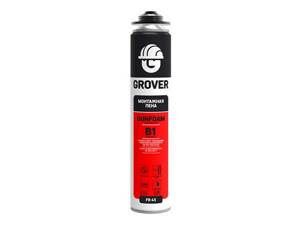
GROVER B1 professional fireproof all-season foam 750 ml. Photo by Maxidom
An important characteristic is foam performance. Cylinder with a volume of 300 ml. on average gives about 30 liters of foam, which is enough to install one door, 500 ml - 40-45 liters, it is possible to install two windows, 750 ml. — 50-55 l. will be enough to seal the cracks of two door frames. Some manufacturers provide consumption parameters for their own products. But the data provided by enterprises implies that work is performed under ideal conditions , which is extremely rare in practice.
In addition, there are calculation formulas . If the seam is rectangular, then the following formula is required - P = W x D, where:
- P—consumption, ml/1m.p of seam;
- W—seam width, mm;
- Г—seam depth, mm.
The formula for calculating foam consumption when filling triangular seams is P = 0.5 x W x D.
Some companies have online calculators on their websites; entering data (seam parameters, type and yield of foam, season of work) into which you can find out the required number of cylinders or seam length. But not a single instruction or calculation method provides an accurate result. All recommendations and directions are approximate. Therefore, it is recommended to purchase foam with a reserve.
Types of heat-resistant foam

Test methods for fire resistance” coordinates the main indicators of a fire-resistant composition. Heat resistance levels :
- B1 - foam with the highest degree of fire resistance. Take for buildings with large crowds of people and an increased risk of fire. Does not support ignition, retains insulating properties for a long time.
- B2 - is a representative of the middle class of fire resistance. Used in buildings with low traffic levels. Resists fire for 30 - 40 minutes, then melts, but does not burn.
- B3 - flammable composition. Can burn, but goes out if the flame source stops working. Due to its low effectiveness, it is not used as polyurethane foam for high temperatures.
Depending on the number of constituent elements, foam can be single-component or two-component.
One-component
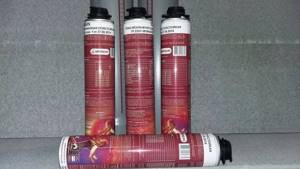
This category includes foams most often used for household use . These materials are offered for sale in aerosol cans.
Action of one-component compositions:
- the mixture, before it is released from the cylinder, contains a liquid prepolymer, which is mixed with the propellant in a gaseous state;
- the second substance can boil when the pressure increases, which it does when leaving the container;
- liquid prepolymer forms stable foam;
The first stage of polymerization occurs when the foam is expelled under pressure by reacting with a moist atmosphere or surface. The expansion of the mass stops at the end of polymerization.
Valera
The voice of the construction guru
Ask a Question
To speed up hardening, you need to spray the surface of the foamed seam with water. This action will increase polymerization; water consumption is 40 ml per medium cylinder of foam.
Two-component

composition is mixed before use , usually the bulk must react with the hardener. The expansion coefficient matters. The indicator depends on temperature, humidity, and exit speed. When laying foam in the seam, take into account the free space for expansion of the composition. Typically foams expand 60 – 300%.
Information about expansion is on the packaging, but the information is valid under ideal conditions :
- ambient air humidity - 50%,
- temperature - 20 - 24°C.
Valera
The voice of the construction guru
Ask a Question
Two-component compositions are used for wide gaps (more than 2 cm). They are often applied with a spatula, since they are not sold in tubes, but in separate containers. Foam guns are also used, but with the inclusion of a pumping device in the design that takes the composition from the container. The constant advantage of a two-component solution is its high expansion coefficient.
Criterias of choice
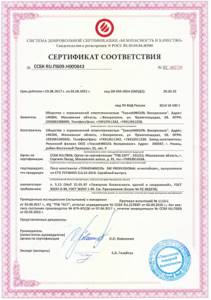
The manufacturer, through a network of suppliers, must provide a certificate of conformity for the product . It confirms the quality of the product, which corresponds to the requirements of GOST 30247.0-94 in terms of fire resistance.
Factors taken into account:
- manufacturer, his fame and popularity;
- the weight of the container, which is determined for the purpose of economy;
- degree of fire resistance, composition, cost;
- volume of space to be filled;
- best before date;
- packaging option.
Foam for household use is sold with a removable tube. It is used for small volumes, for example, for foaming the outside of the front door. For large volumes, they take professional packaging, which is used with a special gun.
Manufacturers
Many manufacturers offer refractory compounds; large companies often have more than one option in their product range.
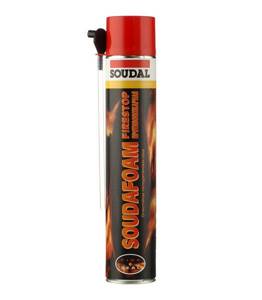
Soudal fire-resistant mounting foam 750 ml. Photo Petrovich
Here are some examples:
- Makroflex FR77 PRO with a fire resistance coefficient of 240 minutes and fire resistance class - B1;
- Tytan Professional B1, marking demonstrates the fire resistance class, one-component composition is intended for use at temperatures from -10 to +30 degrees;
- TECHNONICOL 240 PROFESSIONAL is a one-component foam characterized by an affordable price, which gives it an advantage over foreign analogues;
- Soudal offers three options at once: for domestic use, for professional needs and with the “Click & Fix” marking;
- OGNEZA EI240 is applied at temperatures from +5 to +35 degrees, operated - from -40 to +80;
- Penosil Premium Fire Rated Foam B1 - summer foam that can withstand fire for three hours;
- NULLifire FF197 is a one-component professional product from an American manufacturer;
- Remontix is a Russian-made foam with an optimal price-quality ratio.
These options for fire-fighting compounds are not a complete list of offers from manufacturers. Other businesses and firefighting equipment are presented separately.
Poll: which is the best?
Each performer has his own opinion about the quality of fire-resistant foams, which can be expressed in a survey and in the comments to the article.
How does fire resistant polyurethane foam matrix work?
The basis for the manufacture of fire-fighting mass remains the same polyurethane foam, but now saturated with special extinguishing additives, which do not fundamentally affect the characteristics of the foam mass as a building material.
Thanks to additives based on sodium silicates, chromium and barium salts, it is possible to provide protection for polyurethane foam under conditions of strong heating and direct exposure to the combustion front:
- Minimize the heat flow generated by the flame, penetrating into the interior of the fire-resistant polyurethane foam, thereby eliminating thermal degradation and decomposition of the foam mass;
- Block the penetration of smoke and volatile substances generated during combustion through the fireproof layer of polyurethane foam, including carbon monoxide, dioxins and decomposition products of facing plastic and insulation;
- Reduce the susceptibility of combustible polyurethane foam to the front of an open flame. Due to the release of inhibitor additives to polyurethane, fire-fighting foam does not support combustion as actively as conventional installation material.
For your information! When it comes into contact with a flame, the fire-fighting foam mass is charred and partially burns out in a thin surface layer, darkens, smolders, and compacts to a strong crust.
A black charred crust of fire-fighting foam, saturated with fire retardants and residues of decomposition products, like a shell, insulates the polyurethane foam from contact with air oxygen and hot flames.

As a result, everything that is burned and charred does not crumble into light ash like paper ash, but remains on the surface of the mounting compound. High-quality fire-fighting foam behaves like a drop of liquid glass caught in a fire. When heated, the drop instantly boils and foams into a porous, non-flammable mineral mass with excellent fire-fighting properties. This is how additives in fire-fighting foam work, only their content in the installation mass is an order of magnitude less, otherwise polyurethane foam would simply be impossible to squeeze out of the cylinder due to its enormous viscosity.
Thus, fire-resistant fire-resistant foam is able to isolate a hot fire even if there is no open flame.
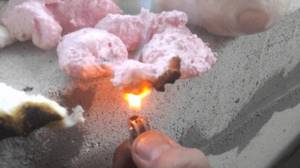
In accordance with the requirements of building regulations, fire-fighting foam is used to install ventilation system doors in rooms with ideal conditions for instantaneous combustion front propagation:
- In offices and institutions with a large number of visitors;
- Shopping centers, hospitals, cinemas and even stadiums;
- Warehouses, storage facilities, underground parking lots.
Polyurethane foam with fire-fighting properties is used to fill installation boxes with electrical wiring, and secure boxes with automation, power systems for fire gate drives, and automatic fire alarms. In some cases, building codes No. 2101-97 allow only surface sealing of the installation layer with fireproof foam, but most often they require filling the opening with 100% fire-resistant material.

Materials are divided into three categories, of which B1 - fire-fighting mass does not ignite and does not burn even when in the front of a flame, B2 - high-quality self-extinguishing polyurethane foams, B3 - mixtures with high flammability.
How to choose
When choosing, it is recommended to pay special attention to products from well-known brands . The purchase should be made from trusted suppliers, then the characteristics will correspond to the declared ones. There is no need to purchase products at a price much lower than stated from the manufacturer and official suppliers. There is a high probability of buying a low-quality product. Materials from leading brands are often counterfeited , hence the large number of negative reviews about foams from certain brands, in particular TECHNONICOL.
It is important to pay attention to the volume of the cylinder and the foam yield ; for different manufacturers, the first indicator may be the same, and the second may vary significantly.
Class B1 foam is recommended for installation of stoves and fireplaces, B2 - for insulating water supply, sewer, and heating networks, B3 - suitable for use in non-residential premises where there are no sources of open fire.
Which foam is better to prefer, choice by cost?
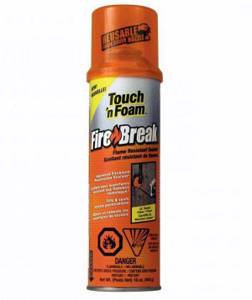
Manufacturer: FireBreak Heat-resistant characteristics partly influence the cost; as a rule, if you take the average cost on the market, one bottle will cost 400 rubles. subject to standard volume. The purchase orientation should be focused on the number of minutes of hardening, as well as the characteristics of the level of fire resistance. But, remember that the price may well exceed the mark of 500 - 600 rubles. After all, this is partly influenced by the manufacturer and his brand. You can also use cheaper heat-resistant polyurethane foam; as a rule, there are few people making counterfeits these days; at this price range it is not profitable.
Recommendations for use
The method of application of polyurethane fire-resistant foam is no different from the use of conventional polyurethane compounds. Before use, you need to find an inconspicuous place and squeeze out the first portion, i.e. Carry out a test application to ensure the foam supply is evened out. The work is performed in the following order:
- working surfaces are cleaned of dirt, dust, oil stains, and moistened;
- Depending on the type of foam used, a gun or tube attachment may be required;
Reference. Pistol compositions can also be used at home, this ensures a more uniform application.
- The container is shaken vigorously for 30 seconds;
- the cylinder is turned over with the valve down at an angle of 90 degrees to the surface, foam is applied, the cavities are filled by 30-50%;
Reference. It is recommended to apply the mixture at positive temperatures, this will allow you not to increase consumption and achieve the best result, which can be obtained at temperatures from +20 to +23 degrees.
- after drying, the excess is cut off;
- The sealant is protected from ultraviolet radiation.
Important! Manufacturers' recommendations for use must be followed.
Preparation for use and use
The standard volume of the can is 750 - 850 ml. There are two options:
- pistol cylinders (Gunfoam);
- containers with a plastic spout or straw.
Download: Instructions for using fire-resistant foam Hilti.pdf Use algorithm:
- Place in warm water - the mixture inside will liquefy, which will improve the release process. In the cold, the polyurethane mass thickens.
- Shake vigorously (30 seconds): the mixture should be well mixed.
- A tube is placed on the cylinder or the container is placed in a gun (professional products).
- The surface is cleaned of dust, dirt, and degreased. For 1-component mixtures, it must be moistened with water, it is advisable to then moisten the splints (rollers).
- Apply to the surface. The bottle is turned upside down.
- Drying process - the composition will harden in a few minutes, but will be finally ready in 6 - 24 hours.
- The excess is cut off.
- If the sealant requires protection from ultraviolet radiation, then it is covered with plaster, paint, and covered with slabs (plasterboard).

Sealing of holes and other work are carried out taking into account:
- with rapid extrusion, the material slowly expands, but penetrates deeper into small cavities (better for penetrations), and vice versa;
- The fire resistance of some brands depends on the size of the seam. Often the instructions contain tables with values, maximum penetration sizes;
- Expansion should be taken into account when applying:
- primary – immediately upon exit, on average 2 times;
secondary - the indicator is indicated by the manufacturer (25 or 30% usually). Incorrect calculation can result in deformation of the object (after 6 - 18 hours). There is less risk if there is space for the mass to squeeze out on its own - the excess part is cut off;
Approximate temperature conditions (options from several instructions):
- storage, transportation: -10 / +25, but up to +50 °C;
- applications: 0 / +40, -5 / +35, +10 / +30 °C;
- cylinder when using: +18 / +25, +5 / +30 °C;
- operation: -30 / +100, -60 / +90 °C;
- triggering – depending on EI;
- optimal for hardening:
- +18 / +35, less often -12 / +35 °C. The higher the temperature, the slower;
humidity up to 65%;
- The hardened fire-resistant coating does not react to temperature changes.
Step-by-step application instructions
Instructions for use:
- The base is cleared of debris and dust. It is then prepared by moistening it with water.
- The suitable temperature for applying foam is 20 degrees Celsius. The cooled cylinder should be kept indoors for some time if it was brought from outside in frosty weather. After this, they are immersed in warm water, but strong heating is prohibited.
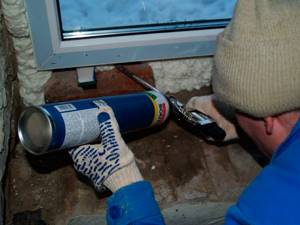
Using foam to install window structures
- The cylinder is shaken and inserted into the gun.
- The seams are filled with the foam composition of the balloon. If vertical surfaces are treated, the sealant is applied from bottom to top.
It is recommended to wet the foam with water to catalyze the expansion and hardening process. This prevents the formation of droplets. It is enough to use a fine spray.
Sealing seams in saunas and baths
offers its services for insulating houses made of timber and logs located in Moscow, the Moscow region and surrounding areas.

We are official dealers of manufacturers producing premium sealants Remmers, Ramsauer, Oliva and others. Thanks to this, our customers can order sealing with branded products on favorable terms.
In our company, the main emphasis is on the quality of the services provided. We carry out triple quality control of the work performed. Masters undergo regular training and advanced training.
To contact us, go to the “Contacts” page, where you will find our contact details and the form for submitting an application.
Calculate the cost of painting and insulating your home right now
The benefits of water procedures for the physical and mental health of the human body have been known to people since ancient times, and visiting a sauna or bathhouse for a modern resident of a metropolis is one of the ways to spend time with benefit for well-being, improve your health and relax. Many owners of individual houses and cottages install a sauna in their home so that they do not have to adjust to the opening hours of establishments that have a sauna or bathhouse, but can relax in the company of friends and take spa treatments at any time.
To decorate baths, various building materials can be used, from tiles and ceramic tiles to various types of natural stone and wood. The main requirement for facing materials in rooms with high humidity is that they do not allow steam and water to pass through and protect walls and floors from destruction due to moisture. The most vulnerable places in saunas and baths, through which moisture can penetrate the walls, are joints, seams and cracks in finishing materials.
High-quality sanitary sealants SDM-CHEMIYA are designed specifically for sealing and sealing seams in the plumbing area, saunas, baths, steam rooms. These materials are made on the basis of silicone with the addition of a fungicide - a biocide against fungi and mold. Such a sealant, for example special silicone, hardens very quickly and, when frozen, is non-toxic, odorless and resistant to aggressive substances (detergents, essential oils, etc.).
Waterproof sealant and steam-resistant sealant for sealing joints in saunas and baths provides sealing of connecting and expansion joints on a wide range of building materials; it has high adhesive properties to ceramics, porcelain stoneware, plastic, and various types of natural stone. This sealant has high elasticity, its elongation at break is up to 400%, so cracks and tears will not appear on it.
Plumbing sealant is also highly resistant to mechanical stress, aging, ultraviolet radiation and is able to maintain its properties over a wide temperature range - from -40C to 180C. This high-quality heat-resistant sealant is suitable not only for indoor work, but can also be used to seal joints and seams outside the building.
The list below includes;sealant for laminate, wood sealant, parquet sealant; sealant for sealing joints on wooden floors; |
2. During slanting rains and side winds, water literally pours down the outer wall. When there are gusts of wind, such streams may seep into the bathhouse. Such cases are especially common for timber whose ridge height is small and the shape of the lock is not provided with special drains. We talked about this in the article.
https://www.youtube.com/watch?v=QklPPVJtwYQ
3. When building from raw timber, the timber almost always cracks and becomes curvature along the longitudinal axis. This leads to the formation of additional cracks and cracks not provided for in our dream of a wooden frame. The size of the cracks is sometimes so impressive that even birds cannot resist the temptation to tear the insulation out of the cracks and steal it to build their nest.
Wind, water and feathered builders will gradually make your log house drafty and cold. This is where we turn to a sealant for help, which will not only block the sparrows’ access to tow and jute, but will also prevent water from getting into the space between the crowns of the frame.
Despite the fact that the site is dedicated to the technology of building a bathhouse with your own hands, for now we will skip the research on “how to make a sealant with your own hands.” It's quite difficult. Of course, there is a way to make the sealant yourself, but the first frosts and sun will reduce your efforts to zero. It is difficult to produce synthetic materials at home!
Features of sealants for steam rooms
Despite the huge offer of all kinds of sealing compounds, choosing a sealant for a wooden bath is not so easy. Many of the products presented on the construction market are not suitable for a bathhouse, because... do not meet the requirements for such compositions.
General requirements for sealing compounds for baths
Criteria for choosing a sealant for a steam room:
- Environmentally friendly and safe, contains natural ingredients. The product should be odorless and emit no harmful substances. This is a particularly important condition when sealing indoors. At the extremely high temperatures found in saunas, volatile chemical compounds are released into the atmosphere and can cause serious poisoning.
- Vapor permeability. It is necessary that natural air circulation be maintained in the bathhouse, since in its absence the room will not dry out well, which threatens the formation of mold.
- Moisture resistant. The sealant should repel moisture and protect the joints from water penetration.
- Must be heat-resistant and resistant to large temperature changes.
- High elasticity. The sealant must have the ability to stretch to at least 25% of its original length.
- UV resistance. This property is important for all types of sealants used outside the house.
What sealants can be used in a bath
The following products are best suited for sealing the steam room:
- Butyl rubber tape. It has good adhesion and ease of use. However, its price is quite high, and in addition, under the influence of high temperature the material can be deformed.
- Thiokol sealants are in the form of a paste or putty, consisting of several components and requiring dilution. To apply the composition correctly, you need to have certain skills, and mixing the ingredients is also difficult.
- Acrylic sealants. They best meet the requirements for sealants for steam rooms and saunas. They are produced on the basis of acrylic dispersion, which is safe for health. They are characterized by high elasticity, do not interfere with the air exchange of wood, and withstand high temperatures well.
What materials are undesirable to use in a steam room?
It is not recommended to use silicone and polyurethane compounds to seal the bath. Such sealants have insufficient adhesion to wood. In addition, many of them contain substances that cannot be used in interior spaces, especially in those where there is a sharp change in temperature.

